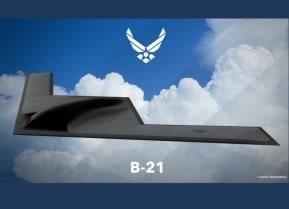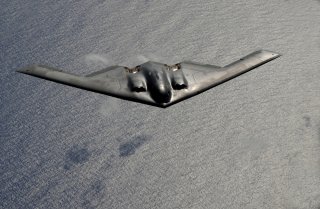B-21 Raider: How Many Stealth Bombers Does the Air Force Need?
With news breaking recently that Washington, at most, can only count on a handful of the new stealth bombers in the coming years - caping out at being able to build ten B-21s per year by sometime in the 2030s - many are asking an obvious question: how many B-21 Raiders does the U.S. military need?
The U.S. Air Force is retiring strike aircraft at an alarming rate. At the same time, concerns are mounting over whether Washington is ready to wage a great power war against Russia or China if a crisis breaks out.
That means, in theory, the Air Force needs as many B-21 Raider stealth bombers as possible. In the past, numbers as high as 200 or more new planes have bounced around Washington and in op-eds over the years. Some experts and policymakers, such as former Trump National Security Advisor Robert C. O'Brien, told the National Interest recently that 300-400 new stealth bombers were needed due to the military threat from Beijing.
The most accurate assessment I would bank on would be from the Heritage Foundation's air power expert John Venable, who told me that he thought in the "near term," 100 B-21 Raiders were possible, with 168 stealth bombers being the most likely "long term" number.
But with news breaking recently that Washington, at most, can only count on a handful of the new stealth bomber in the coming years - caping out at being able to procure 10 B-21s per year by sometime in the 2030s - many are asking an obvious question: how many B-21 Raiders does the U.S. military need?
I put that question to several top experts I have worked with over the years to come up with some straightforward answers.
B-21 Game: 100 Bombers Could Work
"With respect to the B-21, it's hard to say because everything depends on context," explained Dr. Robert Farley, an Air Force expert at the University of Kentucky.
"I haven't seen any good analysis of how many B-21s specifically would be needed, but my sense is that it's more than 20 (B-2 numbers) and that 100 might be fine, depending on how survivable the aircraft turns out to be in a combat environment. Attrition is inevitable, even for a stealth aircraft, but 100 gives a nice cushion while also ensuring constant pressure against Chinese forces."
Some Defense Experts are Skeptical
"I am leery of the U.S. Air Force's intent to buy/produce 100 B-21s," explained Retired U.S. Army Lt. Colonel Daniel Davis, a Senior Fellow at the national security think tank Defense Priorities, in a long-form interview with National Interest.
He continued, noting that: "[T]he unit cost is presently claimed to be $692 million per copy in 2022 dollars. The DDG-1000 Zumwalt Destroyer program was originally slated to produce 32 warships, but was then reduced to 24, then 7, and eventually three. The cost per unit exploded, by 53%, to $4.8 billion a pop. If the U.S. Air Force produces 100 B-21s, then the unit cost is claimed to be nearly $700 million each. But with America's military acquisition history, nothing is ever produced on time, or at anywhere near the budget projections. The likelihood is high that we'll never buy 100, and thus the unit cost will likewise explode.
The Russia-Ukraine war is showing that the trend is towards ever-advancing unmanned platforms. Spending nearly a billion dollars on one manned bomber is not smart, as we need more and cheaper unmanned platforms. If you lose one B-21, a significant portion of your capacity is knocked out. But if you lose a bunch of less expensive unmanned platforms, you can continue to function (and along with that, we need to have platforms that can be manufactured in short order - not years-long per airframe).
So sure, we need some manned planes, but possibly 20 or 30. Or, we just keep upgrading and modernizing the B-52s, B-1s, etc, and put most of our money and future in unmanned airframes we can afford to build (and afford to lose)."
Davis also put the B-21 Raider in the context of the Ukraine war in a different way, urging others to:
"[L]ook at how Russia has been very reluctant to use its most expensive Su-35 fighters, the Ukraine side rarely uses its best fighter jets, and the Russians have been almost unwilling to use their new Armata tanks. Because they are so expensive. And even in our own history, we were always very reluctant to use our new F-22s and some of the other kind of expensive air frames, because we didn’t want to risk losing them.
It doesn’t do any good to have expensive airframes that you’re afraid to use. It’s much wiser to have platforms that perform necessary functions, but are unmanned, and at affordable prices. If we build a future that makes using high-tech weapons cost-prohibitive we rarely use in combat situations, then they do us no good. We have to have platforms that can do the job, yet won’t break the bank, and can be lost in combat without costing us capacity.
Bottom line, the B-21 program is pursuing the wrong objectives."
How Does China See the B-21?
I asked Ian Easton, a long-time China watcher and expert at the Project 2049 Institute in Washignton, DC, for his take on how Beijing sees the B-21 Raider.
He explained that "[A]vailable evidence all suggests Chinese Communist Party strategists are haunted by the specter that their forces might face American stealth bomber strikes during a Taiwan Invasion scenario, something which would make it extraordinarily difficult for them to take and occupy that country.
Easton also stressed that "[B]eijing has invested heavily in the construction of a massive air and missile defense network across from Taiwan. But it almost certainly cannot defeat raids from advanced American platforms. Looking ahead, the US Air Force’s B-21 stealth bomber program is vital for ensuring that the CCP doesn’t miscalculate, assume a Taiwan invasion would come at an acceptable cost, and break the peace."
Harry J. Kazianis (@Grecianformula or Email: [email protected]) is the new Senior Director of National Security Affairs at the Center for the National Interest. He also serves as Executive Editor of its publishing arm, The National Interest. He previously served as part of the foreign policy team for the 2016 presidential campaign of Senator Ted Cruz and the John Hay Initiative. Kazianis, in the past, also managed the foreign policy communications efforts of the Heritage Foundation, served as Editor-In-Chief of the Tokyo-based The Diplomat magazine, and as a WSD-Handa Fellow at the Center for Strategic and International Studies (CSIS): PACNET. Kazianis has held foreign policy fellowships at the Potomac Foundation and the University of Nottingham. He has provided expert commentary, op-eds, and analysis for many outlets, including The Wall Street Journal, Yonhap, The New York Times, Hankyoreh, The Washington Post, MSNBC, Fox News, Fox Business, CNN, and others.
Image: Shutterstock.


